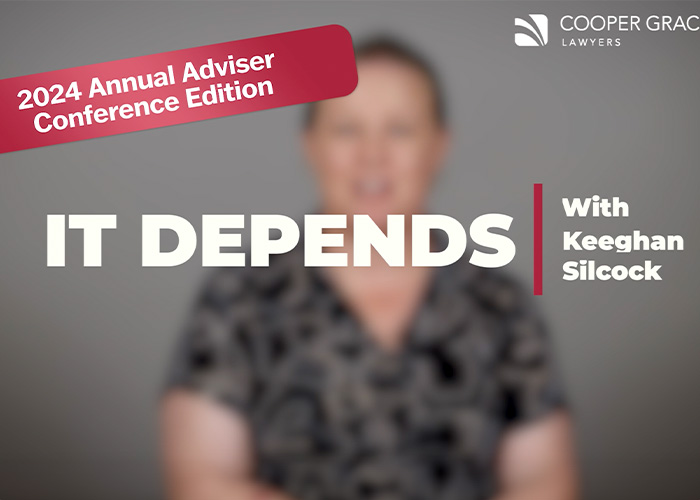Who, what, where with lawyer Madeline Treschman. Hear how long she's been at Cooper Grace Ward Lawyers, what she would be doing if she wasn't working in law and what ...

In this edition of ‘It depends’, senior associate Keeghan Silcock talks about trust cloning and how it can be used.
Keeghan, along with Clinton Jackson, will be covering this topic in more detail during their session ‘The many uses of trust cloning’, at our Annual Adviser Conference on 21 and 22 March. Register now to attend live at Sofitel Brisbane or virtually.
Hi and welcome to another edition of It Depends. Today I’ll be talking about a strategy known as trust cloning and how it can be used. This is a topic which Clinton Jackson and I will be presenting on at the Advisor Conference on 21 and 22 March.
So, trust cloning. This is a strategy which is peculiar to Queensland. It’s used to implement the transfer of an asset from one trust, an asset in Queensland, from one trust to another, trust using a declaration of trust. So, the trustee of the existing trust would declare that it essentially no longer holds it on trust for that trust and instead holds it on trust for the second trust. It’s really important that this is implemented in a particular way because the purpose of doing it this way is so that it does not trigger duty in Queensland.
It depends. Trust cloning is really only available as a strategy in Queensland. So, the asset that we’re looking at has to be in Queensland and it also needs to be held in an existing trust. So, it’s not available if the assets are owned by an individual or a company in its own capacity rather than as trustee for a trust. So, those are the two first important factors. It also needs to be necessary for us to satisfy some technical requirements in implementing the strategy. So, we need to go in potentially to vary the terms of the existing trust, and we need to either set up the new trust, which is going to own the asset or amend an existing trust in a way which makes this trust cloning strategy, work for duty purposes in Queensland. So, those are some technical requirements we need to be able to satisfy. It does have a broader use than I think most people are aware of. So, for example, it’s not necessary that the two types of trust which we’re transferring the asset between need to be the same type. So, we can, for example, transfer an asset potentially out of a self-managed super fund to a discretionary trust which is controlled by the same people. And that’s something that we do quite commonly for people, particularly where they’re wanting to get a business, real property potentially out of a self-managed super fund and into a discretionary trust where it can be held for generations to come.
So, we’re going to be going through some really common examples of how we use a trust cloning strategy at the advisor conference and working through more of the detail about how it’s implemented and some issues that we see pop up. So, if you’d like to come along 21 and 22 March, we look forward to seeing you there.
This publication is for information only and is not legal advice. You should obtain advice that is specific to your circumstances and not rely on this publication as legal advice. If there are any issues you would like us to advise you on arising from this publication, please let us know.
Subscribe to our interest lists to receive legal alerts, articles, event invitations and offers.
Cooper Grace Ward acknowledges and pays respect to the past, present and future Traditional Custodians and Elders of this nation and the continuation of cultural, spiritual and educational practices of Aboriginal and Torres Strait Islander peoples.
Fast, accurate and flexible entities including companies, self-managed superannuation funds and trusts.